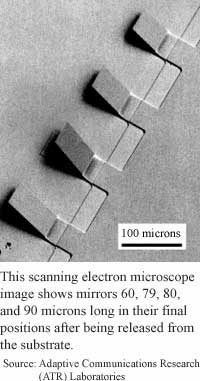
Micromachine
parts relax into place
By
Chhavi Sachdev,
Technology Research NewsBorrowing from origami, the art of paper folding, a team of Japanese researchers has arrived at a more practical way to position parts in microscopic machines.
Microscopic machines typically include hinged parts that must either lock into a predefined position or remain movable. Devices with moving parts, however, are extremely difficult to manufacture at the micron level.
Presently, fabricating the hinges is a multi-step process, involving the deposition of polysilicon, or silicon that has been doped to become metallic, as well as photolithography, a method of etching patterns on chips using light sensitive films and masks that itself takes many steps. Positioning the hinges is difficult and the resultant sliding parts are prone to wear and tear.
Researchers at the ATR Adaptive Communications Research Laboratories in Kyoto, Japan have constructed an array of tiny hinged mirrors that snap into place without the need for a manual or electrostatic push from outside the system. Instead, the energy to move the micromirrors to their final positions comes from the very structure of the material.
The mirrors, which are 50 microns wide and 60 to 90 microns long, are made from a sandwich of the semiconductors gallium arsenide and aluminum gallium arsenide. The key to the self-contained positioning energy is depositing the sandwiched material as a layer on the surface of another material, or substrate, whose atoms are spaced farther apart. "The atoms in the deposited layer are forced to align with the same spacing, [or] lattice constant, of the substrate," said Pablo Vaccaro, a senior researcher at ATR.
Because these layers are elastically strained to fit the lattice constant of the substrate, they have a latent potential energy that, when released, will power the self-positioning technique," said Vaccaro.
In origami, a final tug often produces the desired shape. In a similar way, the researchers selectively etched away the sacrificial layer beneath the mirrors to unleash the potential energy in the mirrors structure. When the sacrificial layer is gone, elastic strain diminishes causing the mirrors to bend upwards.
This self-positioning technique is not limited to the semiconductors used in this project, said Vaccaro, but will work with any pair of strained layers, whether metal or semiconductor.
What's new is that the researchers have shown that the structure can be implemented in compound semiconductors using layers of material grown on a substrate, said Ming Wu, a professor of electrical engineering at the University of California at Los Angeles. "This opens the possibility to integrate active optoelectronic components with micromechanical structures and actuators," he said.
The researchers' next step will be to design structures with more than one hinge or with movable parts actuated by electrostatic forces. "We intend also to integrate these components with optoelectronic devices" such as laser diodes, LED’s, sensitive light detectors, and optical modulators, Vaccaro said. The hinged mirrors could also be used in microelectromechanical systems (MEMS) that include standing and scanning mirrors, diffractive lenses, as well as optical cavities, scanners, and filters, he said.
Vaccaro’s colleagues were Kazayoshi Kubota and Tahoto Aida at ATR Adaptive Communications Research Laboratories. They published their findings in the May 7 issue of Applied Physics Letters. The research was funded by the Japanese government.
Timeline: >2 years
Funding: Institute, Government
TRN Categories: Microelectromechanical Systems (MEMS); Materials Science and Engineering
Story Type: News
Related Elements: Technical paper, “Strain-driven self-positioning of micromachined structures” in Applied Physics Letters, May 7, 2001.
Advertisements:
June 27, 2001
Page One
Chemists concoct tiny lasers
Slimmer chips handle fast nets
Prototype transistors promise speedy chips
Molecules make short-term memory
Micromachine parts relax into place

News:
Research News Roundup
Research Watch blog
Features:
View from the High Ground Q&A
How It Works
RSS Feeds:
News
Ad links:
Buy an ad link
| Advertisements:
|
 |
Ad links: Clear History
Buy an ad link
|
TRN
Newswire and Headline Feeds for Web sites
|
© Copyright Technology Research News, LLC 2000-2006. All rights reserved.